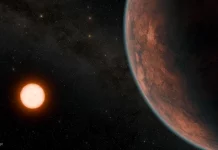
Scientists from The University of New Mexico and MIT have found two new planets that take a long time to go around their star.
These planets are special because they remind us of the planets in our own solar system, which also take a long time to complete one orbit around the Sun.
These new planets are called TOI-4600 b and c, and they go around a star that is a bit smaller and cooler than our Sun.
The scientists used a space telescope called TESS to spot these planets. TESS takes pictures of the sky and watches for changes in starlight.
When a planet moves in front of a star, it blocks a little bit of the light, and that’s how TESS knows a planet might be there.
Usually, TESS can only find planets that go around their star really quickly, in less than 40 days. But TOI-4600 b takes almost 3 months, and TOI-4600 c takes about 16 months! That’s why these planets are so interesting.
The scientists then used telescopes on Earth to double-check that these really were planets.
Ismael Mireles, the scientist leading the study, explained that finding these planets is like finding a needle in a haystack. He and his team used math and computer models to be sure they were right. They also got help from amateur astronomers.
These are people who love watching stars but aren’t professional scientists. With their help, they could confirm these planets were the real deal.
So, what are these planets like? TOI-4600 b is about seven times bigger than Earth and hotter too, with a temperature of 170 degrees Fahrenheit. TOI-4600 c is even bigger—about nine and a half times the size of Earth—and is one of the coldest planets found by TESS, with a temperature of around -110 degrees Fahrenheit.
These new planets are interesting because they could help us understand how planets form. Most of the over 5,000 planets we’ve found outside our solar system are very different from ours. But these two new ones are a bit similar, which makes scientists wonder how they got there and what else might be in their solar system.
Finally, the researchers say that anyone interested in stars and planets can help. On October 16, there will be another chance to watch one of these planets move in front of its star. Even if you have a small telescope, you can join in and help scientists confirm their findings.
So, if you love looking at the night sky and have some tools for it, you could be part of this big space discovery!
The study was published in the journal The Astrophysical Journal Letters.
Follow us on Twitter for more articles about this topic.
Source: University of New Mexico.



